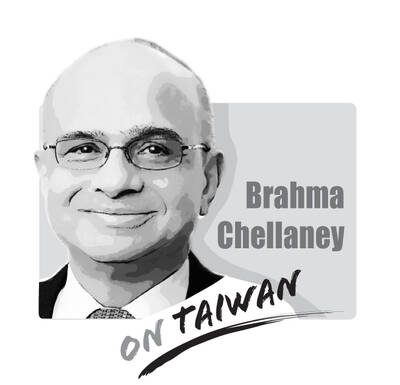When a memorial to Chen Wen-chen (陳文成) at National Taiwan University (NTU) was dedicated in February after a decade of campaigning, many were surprised that the plaque was made of polystyrene foam. The placeholder, which was removed after three days, read: “In memoriam of a hero who unyieldingly resisted state violence.”
Apparently, many of the decisionmakers at the university disagreed with the phrase “state violence,” so no text has been displayed for the past few months, which is a shame given NTU’s colorful history and what Taiwanese endured to achieve its free and democratic environment.
On Saturday, NTU finally approved the text after student representatives brought the issue to an online vote, winning 74 to 64.
Some professors who voted against the text cited the need to “maintain tranquility on campus” — an egregious statement, as more people in Taiwan should learn about the atrocities that the previous authoritarian regime has committed.
Tranquility is achieved by acknowledging history and reaching an understanding, not by ignoring issues.
Chen, an assistant professor of mathematics at Carnegie Mellon University in Pittsburgh, Pennsylvania, was visiting family in Taiwan when he was found dead near a library at NTU on July 3, 1981.
The state ruled it a suicide, and although the facts are not entirely clear, evidence indicates that he was killed and thrown off the building, possibly by state security from the Taiwan Garrison Command, the then-Chinese Nationalist Party (KMT) government’s main instrument for its nearly four-decade-long reign of White Terror. Chen was detained and interrogated the night before his body was found.
The authorities claimed that Chen killed himself out of guilt for his “crimes” — ie, supporting Taiwan’s democracy movement. He was reportedly marked for donating money to Formosa Magazine, a major opposition publication that was the flashpoint of the Kaohsiung Incident two years earlier.
Chen was reportedly followed and harassed following his return, and even blocked from returning to the US on schedule.
Even if he were not killed by authorities, what he and countless others who opposed authoritarian rule endured was most definitely state violence. Even though the evidence is not clear on what happened to Chen, so many others were executed, incarcerated or simply “disappeared” that there is nothing controversial about the phrase “state violence.”
Yet, decades after martial law was lifted, it still took a lot of work by the Chen Wen-chen Memorial Foundation and students to get the memorial built. In 2019, the university even rescinded its offer to fund half of the memorial on the grounds that it is a sensitive political topic. In addition, NTU reportedly tried to keep the dedication ceremony as low-key as possible.
Even though university campuses were a major part of the government’s propaganda activities, students at NTU have long been on the forefront of fighting for the nation’s democracy. State violence against its students was committed as early as 1949 during the April 6 Incident, and in 1986 its students launched Taiwan’s first major campus movement calling for freedom of speech and direct representative elections.
Given this history, NTU should embrace the role its students played in democratization instead of hampering their efforts.
Fortunately, the text was approved, otherwise the blank space would have continued to be an insult to those who fought against state violence.

Taiwan stands at the epicenter of a seismic shift that will determine the Indo-Pacific’s future security architecture. Whether deterrence prevails or collapses will reverberate far beyond the Taiwan Strait, fundamentally reshaping global power dynamics. The stakes could not be higher. Today, Taipei confronts an unprecedented convergence of threats from an increasingly muscular China that has intensified its multidimensional pressure campaign. Beijing’s strategy is comprehensive: military intimidation, diplomatic isolation, economic coercion, and sophisticated influence operations designed to fracture Taiwan’s democratic society from within. This challenge is magnified by Taiwan’s internal political divisions, which extend to fundamental questions about the island’s identity and future
The narrative surrounding Indian Prime Minister Narendra Modi’s attendance at last week’s Shanghai Cooperation Organization (SCO) summit — where he held hands with Russian President Vladimir Putin and chatted amiably with Chinese President Xi Jinping (習近平) — was widely framed as a signal of Modi distancing himself from the US and edging closer to regional autocrats. It was depicted as Modi reacting to the levying of high US tariffs, burying the hatchet over border disputes with China, and heralding less engagement with the Quadrilateral Security dialogue (Quad) composed of the US, India, Japan and Australia. With Modi in China for the
The Chinese Nationalist Party (KMT) has postponed its chairperson candidate registration for two weeks, and so far, nine people have announced their intention to run for chairperson, the most on record, with more expected to announce their campaign in the final days. On the evening of Aug. 23, shortly after seven KMT lawmakers survived recall votes, KMT Chairman Eric Chu (朱立倫) announced he would step down and urged Taichung Mayor Lu Shiow-yen (盧秀燕) to step in and lead the party back to power. Lu immediately ruled herself out the following day, leaving the subject in question. In the days that followed, several
The Jamestown Foundation last week published an article exposing Beijing’s oil rigs and other potential dual-use platforms in waters near Pratas Island (Dongsha Island, 東沙島). China’s activities there resembled what they did in the East China Sea, inside the exclusive economic zones of Japan and South Korea, as well as with other South China Sea claimants. However, the most surprising element of the report was that the authors’ government contacts and Jamestown’s own evinced little awareness of China’s activities. That Beijing’s testing of Taiwanese (and its allies) situational awareness seemingly went unnoticed strongly suggests the need for more intelligence. Taiwan’s naval